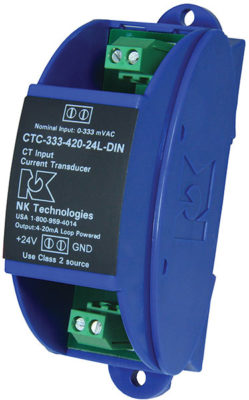In some applications, such as monitoring a high voltage system, using a two-piece solution (current transformer and  separate signal converter) works better than using a one-piece sensor. A two-piece solution is also a better choice when the system is supplied with bus bars, making installation of a sensor over the conductor extremely difficult or impossible.
separate signal converter) works better than using a one-piece sensor. A two-piece solution is also a better choice when the system is supplied with bus bars, making installation of a sensor over the conductor extremely difficult or impossible.
In a two-piece solution, the installer connects the secondary of a standard 5 amp current transformer to the input terminals of the CTC device, and then connects the CTC secondary to a nominal 24 volt DC supply and then to the PLC or panel meter input. The converter will then produce 4mA when there is no current through the primary CT, and 20mA when the CT has full range current present.
As an example, if the requirement is to monitor the current used by a large enterprise, supplied with a 2000 amp, 480/277 VAC service, a split-core CT with a ratio of 2000:5 is installed over the bus in the switchboard. The secondary of the CT can be connected to the CTC, the output signal connected to a panel meter, and the meter can be scaled to read 2000 when the system is fully loaded, or the meter can read 100%. As is always the case, a load (the CTC converter) must be connected whenever the CT is energized.
 CTC Series Signal Converter
CTC Series Signal Converter
Most of NK Technologies' products combine a current sensing element (toroid or Hall effect based) with the signal conditioner in one package. The addition of the new CTC converter makes it possible to convert any 5 amp secondary from a CT or 0.333 VAC signal from a ProteCT™ sensor to an industry standard 2-wire, loop powered 4-20mA output.
The CTC Series provides a solution in applications where installing a one-piece sensor is not possible. And since the sensor output is industry standard, two and one piece solutions can be mixed in the same controller cabinet.
The CTC simply snaps onto a standard DIN rail, making it easy to install and no calibration is required because the primary current transformer ratio provides the scaling required without any installer intervention.
Related Products
MONITORING AC CURRENT
- Photovoltaic power generation
- Plastics injection molders
- Semiconductor fabrication
- Petroleum refining
- Building energy management
- Wood processing
- Water treatment facilities
- Mining processes
